In person, telling the difference between crocodiles vs. alligators is easy. The first time I saw a Nile Crocodile lying on the shore of the Juba River in Somalia, all I could think was, “That’s a dinosaur!”
I’ve seen a few alligators in zoos, gator parks, and floating in water hazards on Florida golf courses. However, I had never seen one of Florida’s crocodiles.
However, when I moved to Africa, I was told there were no alligators on the continent, but there were crocodiles. As an American, the locals even suggested that I probably couldn’t tell the difference between a crocodile and an alligator.
Forty years later, I still keep hearing people say that it’s difficult to tell the difference between a crocodile and an alligator. The difficulty, however, is quickly erased with knowledge of a few significant features and habits of both creatures.
Related: Comparing coyotes vs. wolfs.

Crocodiles vs. Alligators: Spotting the differences.
For the sake of brevity, I’ll be comparing the Nile Crocodile to the American Alligator throughout this article.
The difference between crocodiles vs. alligators is different families (crocodylidae vs. alligatoridae), and crocodiles like briny water or saltwater, have pointed, V-shaped snouts and are light green or brown colored. Alligators prefer freshwater, have U-shaped snouts and are dark blackish-grey.
Crocodiles and alligators both come from the Crocodilia order, but they are dramatically different creatures. Crocodiles are up to four times as heavy as alligators, and while both are dangerous, the crocodile is more aggressive.
Crocodiles live in Africa, Australia, Central America, Southern U.S., and in parts of the Pacific. Alligators are found only in the Southern United States and China.
| American Alligator | Nile Crocodile | |
| Size | Adults, 11-15 feet in length. Weight up to 1,000 lbs. The largest recorded = was 19 feet long and weighed 2,220 lbs. | Adults, 10-15 feet in length. Weight up to 1,000 lbs. The largest Recorded = was 20 feet long and weighed 2,400 lbs. |
| Teeth | 74-80 teeth. When the mouth shuts, the fourth lower teeth are enclosed in a pocket in the upper jaw and are not observable. | Up to 68 sharply pointed, cone-shaped teeth that replaceable. On each side of the mouth, five teeth are in the front of the upper jaw, 14 are in the rest of the upper jaw, and 15 are on both sides of the lower jaw. The enlarged fourth lower tooth fits into the notch on the upper jaw and is visible when the jaws shut together. |
| Bite Force | Max: 3,000 lbs per foot. | Max: 5,000 lbs per foot. |
| Feet | Alligators have webbed feet, but they do not have jagged fringes. | Crocodiles have a jagged fringe on their hind legs and feet, but they are not webbed. |
| Meat | Consumed regularly enough for profitable farming of alligators. Described as tasting like quail. | Eaten in some countries (Thailand consumes over 20,000 per month). Described as tasting like pork. |
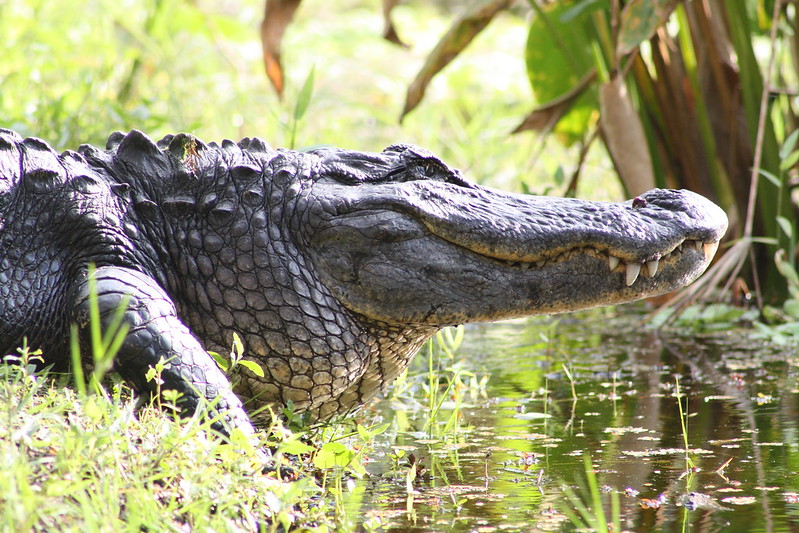
Crocodiles vs. alligators: Differences in diet.
The Nile crocodile’s diet is primarily fish, which the herd into place with their tails before consuming. However, the Nile crocodile is notorious for ambushing and eating small hippos, leopards, porcupines, zebras, birds, and other crocodiles.
Crocodiles will eat anything that moves, and just about anything that is already dead.
American alligators eat mostly smaller fish, frogs, birds, reptiles, and turtles. However, they are also known to opportunistically take domestic animals such as cats, dogs, and calves, and carrion such as bears and deer.
Neither animal chews its food; they both swallow torn-off pieces whole. In addition, neither crocodiles nor alligators have jaws structured to move sideways, only up and down.
Interestingly, both alligators and crocodiles swallow stones to act as ballast. This is because the rocks help them remain submerged for a longer time.
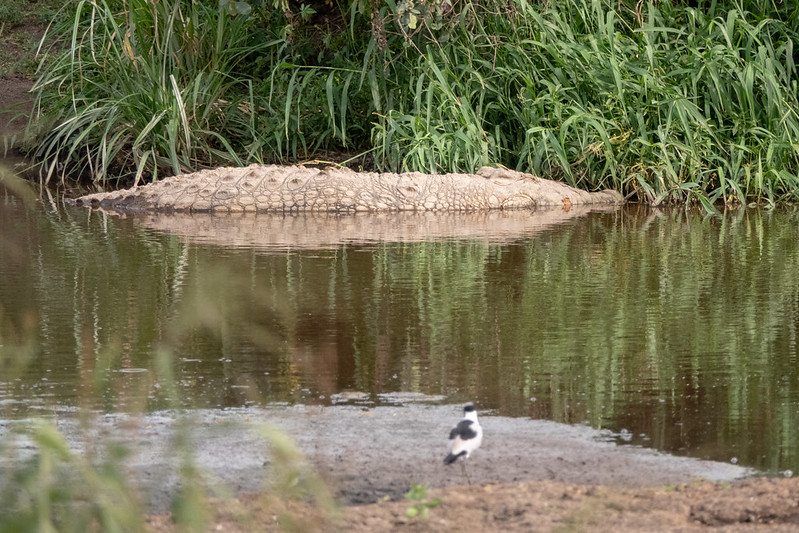
Alligators vs, crocodiles: Danger to humans.
The American alligator has killed fewer than 30 people in the last five decades. Except for an unusual spree in May of 2006 (three people were attacked and killed), fatal attacks are rare—despite heavy reporting of such events and the extent of searches and investigations into missing persons.
American alligators are much less aggressive toward humans and do not regularly inhabit areas populated by people. Most alligator attacks on humans are likely the result of misidentification (on the part of the gator) caused by being submerged in murky water when a human passes nearby.
Those humans that survive the initial attack suffer extreme injury from the gator’s 3,000 lbs of bite force and a severe risk of infection that, despite immediate medical treatment, can cause a fatal infection.
The Nile crocodile is a killer.
On the other hand, the Nile crocodile is a known man-eater and deliberate hunter of humans. During my time in Somalia, so many people were killed or maimed in attacks near water collection points that fencing was installed to keep the crocodiles away.
The Nile crocodile is a hated and feared reptile in many parts of the world. These prehistoric monsters probably take hundreds of people yearly in Somalia, where investigations by authorities and news reports are scarce. If you include India and other countries, the Nile crocodile is probably responsible for thousands of fatal human attacks yearly.
The Nile crocodile is a menace to humanity because it lives in proximity to humans, comes into contact with them frequently, is overly aggressive, and downright considers humans prey. Indeed, even smaller Nile crocodiles will prey upon children.
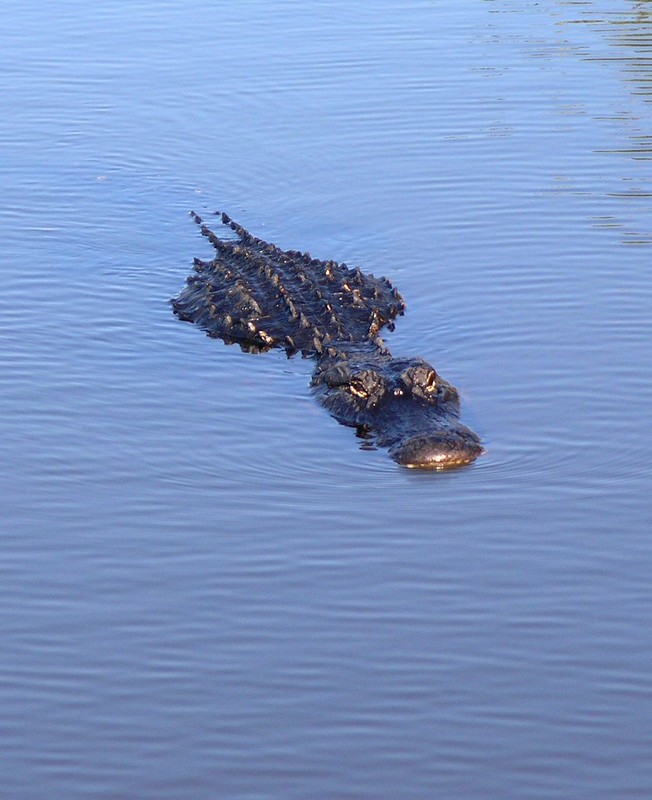
Hunting differences between crocodiles and alligators.
The American alligator hunting style.
The American alligator is renowned for its “death roll,” in which it seizes its prey in its jaws, drags it underwater, and rolls it until it has been drowned or torn into pieces. The less “Hollywood” manner of killing prey is a quick ambush, a crushing grip, and a long soak in the river or pond.
The way an alligator stalks its prey is less active. Alligators lie in wait in tall grass or the water with just their eyes and nostrils above water and the rest of their body hidden. Then, when an unsuspecting animal comes within range, they ambush it.
Ashore, with no water nearby to drown their victim, alligators will shake prey to death by tearing open wounds, dismembering it, and breaking its bones.
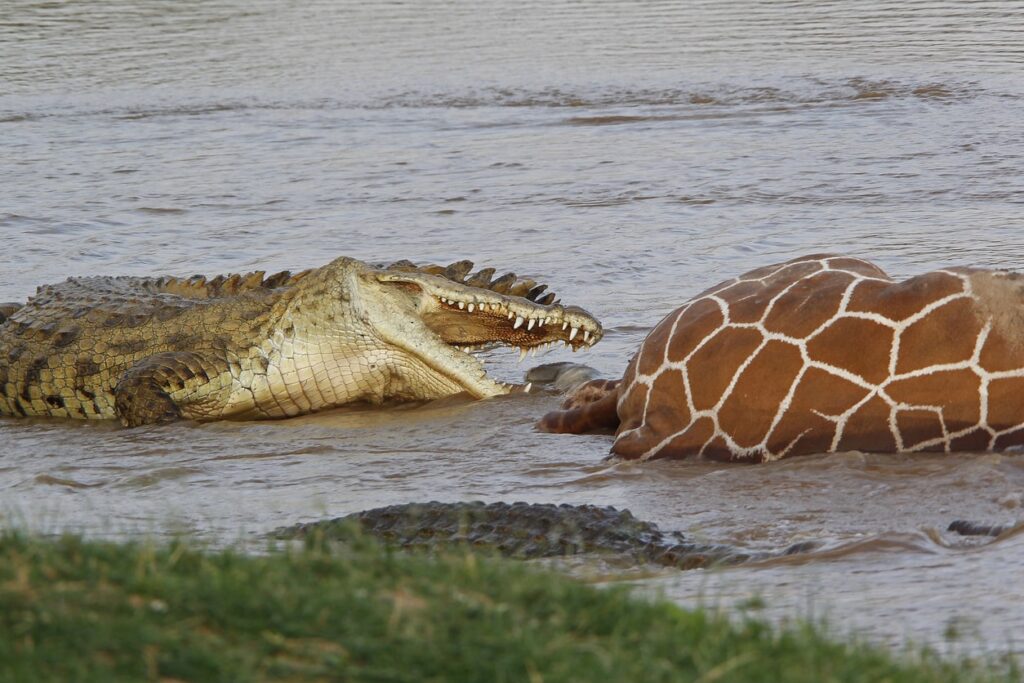
The Nile crocodile hunting style.
Crocodiles are ambush predators, just like alligators. They hunt in the water and on land, much like alligators do. The crocodile’s victims suffer the same fates; being shaken to death, pulled from the shore and drowned, or dragged underwater and rolled to death.
In the crocodiles vs. alligators contest, the difference in hunting is in the size of the prey category. The Nile crocodile can take larger prey (like the giraffe pictured above). However, nile crocodiles can also prey upon sharks in saltwater. This is because Nile crocodiles possess lingual salt glands in their mouths to expel salt from their systems.
How alligators and crocodiles sense their prey.
Both alligators and crocodiles have dome pressure receptors. These receptors allow them to detect motion in the water made by prey and regulate water pressure while swimming.
The crocodile’s receptors are almost transparent and sprinkled all over its body. An alligator’s receptors are black spots near the jawline.
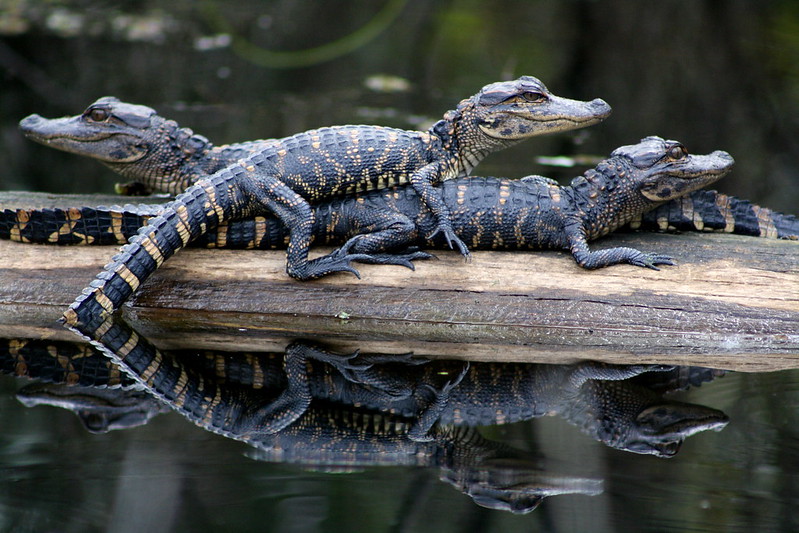
Crocodiles vs. alligators: Lifespans.
After reaching adulthood, very few things on earth prey upon crocodiles or alligators; they are the apex predator of their neighborhood. Indeed, only during their juvenile months is anything capable of killing these prehistoric creatures.
In their youth, alligators are preyed upon by eagles, herons, snakes, and other alligators. Likewise, young crocodiles sometimes run afoul of monkeys, hippos, jaguars, and other crocodiles. Both creatures are also the prey of humans and even human expansion.
There is no difference between crocodiles and alligators when they are nothing more than eggs—nearly every egg eater that discovers their eggs will feast upon them. The same happens to newborns and babies—though their future prey gets to take a little “pay it forward” revenge here.
A crocodile in the wild can live be 70 years old. An alligator, 60 years. Those that live to full maturity reach unbelievable and often record setting sizes. Both will find that humans are their worst and most deadly predators.
Crocodiles vs. alligators: Who can take the coldest temperature?
Thankfully, we have a rapidly cooling temperature zone in the United States as you move up the latitudes.
With each degree of latitudinal change, the temperature drop removes more and more of our American crocodiles and alligators. Indeed, today the crocodile is limited to the most southern tips of Florida.
To survive, the crocodile prefers a temperature that does not dip below 85 degrees. Below that, a crocodile will become dormant and enter survival mode. American alligators, though, can remain active in temperatures as low as 80 degrees before entering the same survival mode.
Crocodile vs. alligator: Which will catch you faster?
The american alligator will quickly overcome you on land, it can hit a short burst of speed at nearly 30 m.p.h.
The Nile crocodile will max out at 22 m.p.h.
If you are trying to swim to shore before one gets you, the crocodile can get up to 18 m.p.h. The american alligator maxs out at 20 m.p.h. You? If you are an average human, you swim about 2 m.p.h.

